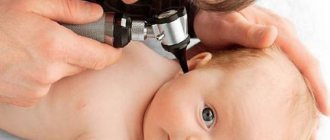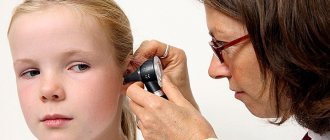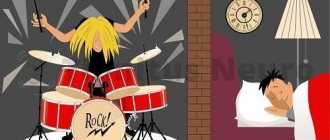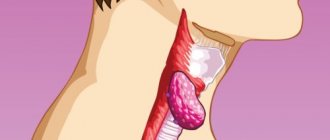Why can your ear hurt when you have a sore throat?
Ear pain with a sore throat is common. It is similar to a sore throat: just as strong, sharp and stabbing. When swallowing, the symptoms intensify and a feeling of stuffiness appears. One or two ears can become inflamed. Before deciding what to do, it is necessary to identify the provoking factor. There are two causes of unpleasant ear symptoms: referred pain and otitis media.
Referred pain
The pharynx, sinuses and ear canals are connected. They are regulated by one nerve - the trigeminal, and pus and pathogenic bacteria penetrate from one cavity to another. Therefore, when you have a sore throat, your ears often hurt.
Referred pain is a standard complication and goes away as the disease subsides.
If the cause is referred pain, the following symptoms appear:
- Slight hearing loss.
- Noise in ears.
- The pain occurs sporadically, at the time of exacerbation of sore throat, and subsides when the general condition improves.
Referred pain is not particularly dangerous. If your ears are blocked, you can prevent complications by simply following the general recommendations for the treatment of sore throat. Symptomatic therapy is used to reduce discomfort.
To relieve radiating pain, sucking tablets, sprays, and antiseptic solutions are used. A compress with lidocaine has a good effect. However, it is prohibited for pregnant women and patients with chronic diseases.
Otitis
A serious complication of sore throat. Bacteria entering the middle ear cause inflammation and the formation of pus. The pathology manifests itself against the background of decreased immunity, vitamin deficiency, previous chronic diseases and hypothermia.
There is a high risk of developing otitis in pregnant women, patients with tuberculosis and diabetes.
Otitis is accompanied by:
- Itching – at the initial stage.
- Sharp shooting pains.
- Significant hearing loss.
- The appearance of noise and a feeling of stuffy ears.
- Dizziness accompanied by nausea.
- The formation of pus, which flows out when the eardrum ruptures.
- Increased body temperature.
Interesting video: how can you cure otitis media at home?
Without timely treatment, the disease becomes chronic. To prevent complications, you need to contact an otolaryngologist (ENT) as soon as your ears begin to hurt. He will help determine the cause of the complication and select appropriate therapy.
How to cope with ear pain with a sore throat, and why it occurs
Having contracted a sore throat, the patient suffers from symptoms already in the first two days, since the disease develops quickly.
In most cases, there is a fever, sore throat, plaque on the tonsils, lethargy, headache, and also a common symptom of sore throat - ear pain. The phenomenon is quite common and can be caused by various reasons. Let's look at why the ear hurts with a sore throat and how to alleviate the condition.
Why can your ears hurt and become blocked when you have a sore throat?
Ear pain with sore throat usually occurs for several reasons:
- Pain radiating into the ear due to tonsillitis - inflammation of the tonsils. When swallowing saliva, painful sensations occur that spread to the parotid area. It is not the ear itself that hurts, but the part of the head around it. This is the so-called referred pain. Gargling with a warm solution of soda, chamomile or calendula infusion can help. The whole effect is based on the fact that when rinsing, the plaque from the tonsils is washed away and the patient feels better for a while. Also, with such pain, warm, generous drinks in small sips will help.
- Trigeminal neuralgia. The trigeminal nerve, whose branches diverge to the eye, upper and lower jaws, can become irritated with sore throat. Irritation of the nerve occurs, and pain from the mandibular branch radiates to the eardrum.
- Inflammation of the middle ear or otitis is another reason why the ear may hurt with a sore throat, if we are talking about complications and spread of infection to the ear. The pain is often shooting and sharp. When the eardrum ruptures, pus may leak from the ear canal.
If any type of pain occurs, it is necessary to visit an otolaryngologist as soon as possible to determine the exact cause. Any self-medication can have unpredictable consequences, including the development of hearing loss and deafness.
With a sore throat, there is often another complaint of stuffiness in the ear or ears. There are several reasons for this:
- Inflammation of the middle ear, causing swelling inside the tympanic cavity, as a result of which the ventilation function is impaired and discomfort occurs.
- Inflammation of the auditory tube - eustachitis - disruption of the patency of the auditory tube due to edema.
- Sulfur plug. Due to the accumulation of wax in the ear canal, there may be a feeling of stuffiness and pressure inside the ear. This is not always associated with sore throat.
What to do if your ear hurts after a sore throat
Sometimes situations arise when the ear hurts after suffering from a sore throat. There are several ways to get rid of an unpleasant symptom. First of all, you need to get an appointment with an ENT doctor. The doctor will examine the ear using a head reflector, otoscope and tympanometer, and then prescribe the necessary treatment.
Treatment with pharmaceutical drugs
As a rule, the doctor prescribes a painkiller based on ibuprofen or paracetamol - Nurofen, Paracetamol. In addition to this, you can use lozenges in the mouth. Swallowing frequently while taking the medication will help relieve pain.
There are several types of lozenges on pharmacy shelves. They can be either with a medicinal substance or with natural components based on medicinal herbs.
If ear pain begins with a sore throat, then you cannot do without an antibiotic based on amoxicillin. Don't ignore this recommendation! The main treatment for sore throat is the prescription of an antibiotic, otherwise there is a risk of complications.
Do not self-medicate; you cannot choose your own medicine; you must consult a specialist.
To relieve pain and fever
When the patient gets better, but the ear still hurts after a sore throat, non-steroidal anti-inflammatory drugs such as Ibuprofen, Aspirin, Nise will come to the rescue. Also, these drugs will help if the sore throat with sore throat radiates to the area near the ear, and the patient has a fever.
Antiseptics for treating the ear cavity
Pharmacy chains also have antiseptics for treating the ear cavity. They will help if your ear is blocked due to a sore throat and you need ear treatment.
These are the following drugs:
- Chlorhexidine and Miramistin are effective disinfectants;
- A-cerumen, Remo-vax - drugs that dissolve earwax;
- hydrogen peroxide - softens the sulfur plug, if that is the problem.
Before using any medications, an appointment with an otolaryngologist is required.
Pain relieving drops
What else can be done about ear congestion, when both ears are blocked due to a sore throat? In addition to the antibiotic, you can drop local anesthetic drops into the ear canal:
- Otipax - based on lidocaine and phenazone.
- Otinum is based on choline salicylate.
- Otizol - based on benzocaine, phenylephrine and antipyrine. To the similar actions of previous drugs, an antimicrobial effect is also added.
All components of the drops have anti-inflammatory and analgesic effects.
Also in the pharmacy arsenal there are antibiotic drops that will help relieve ear pain faster:
- Otofa - based on rifampicin;
- Sofradex – with gramicidin and framycetin;
- Normax – based on norfloxacin;
- Anauran – based on polymyxin B and neomycin.
It should be remembered that drops are used only in cases where there is no perforation - rupture of the eardrum, and after consultation with a doctor.
ethnoscience
In addition to pharmaceutical drugs, some people also use folk remedies. Such as a compress on the parotid area. It happens:
- Dry - a bag of heated salt is applied to the affected area, for example.
- Alcohol - vodka or alcohol is diluted in warm water, cotton wool is soaked in the solution and also applied around the sore ear. The top is insulated with something soft, for example a piece of flannel.
- With camphor oil - the oil is heated, a bandage soaked in this oil is applied to the ear.
However, all these folk remedies will not help unless an antibiotic is prescribed for a sore throat. By being treated only with folk remedies, the patient risks losing his hearing. Self-medication is unacceptable here!
Physiotherapy
An additional way to help with pain is physical therapy. These can be UHF, electrophoresis and magnetic therapy. These methods are considered classics in the treatment of ear pain:
- With electrophoresis, direct current with medicine is applied to the diseased area. The current accelerates the process of penetration of the active substance of the drug into the tissue at the source of inflammation.
- UHF is a procedure that is based on the targeted effect of a high-frequency electromagnetic field on the source of pain. Helps relieve pain. It is appropriate to use in the early stages of otitis development. Each procedure should last up to 5 minutes.
- Magnetotherapy is the use of a low-frequency magnetic field of 50 Hz for therapeutic purposes. This procedure helps relieve swelling and increases the activity of the lymphatic drainage system.
These methods of therapy must be combined with the use of pharmacological drugs, otherwise the treatment will be delayed.
Surgical operations
If you delay in contacting an ENT doctor, if pain occurs, surgical intervention may be required. It's called tympanotomy.
This is a procedure to remove exudate from the ear cavity. The mini-operation is performed under local anesthesia. It consists of a myringotomy, or opening of the eardrum, and the installation of a tympanostomy - a cylindrical tube.
With its help, pus is removed, restoring pressure. Relief occurs immediately after surgery. The purulent contents of the cavity must be transferred to the laboratory for research.
If you have complaints of frequent sore throats and ear pain, you may need to:
- adenotomy or removal of adenoids - nasopharyngeal tonsil;
- tonsillotomy or removal of tonsils - pharyngeal tonsils.
These operations are performed under local or general anesthesia. As a rule, they are most often carried out in childhood, if the child is constantly suffering from sinusitis, otitis media and tonsillitis.
The decision on a particular operation is made at an appointment with an otolaryngologist after a detailed study of the medical history.
How to prevent complications?
If you experience severe sore throat, fever or other symptoms, you should consult a doctor. The patient must strictly follow the recommendations and take all necessary medications to prevent complications after a sore throat.
In most cases, an antibiotic is required. Complications develop primarily as a result of self-medication.
Prevention
The main means of preventing ear pain and complications is:
- Vaccination against pneumococcus and Haemophilus influenzae, as the most common causative agents of bacterial otitis and sinusitis.
- Proper nasal hygiene when you have a runny nose. It is very important to blow your nose correctly, covering one nostril and the other nostril alternately. At the same time, it is important not to blow hard so that mucus does not flow from the nose into the auditory tube.
- Ear hygiene, which involves carefully cleaning the ear canal after a bath or shower. You should use cotton swabs carefully and correctly, as cotton swabs left in the ear canal contribute to the accumulation of wax. It is enough to remove its remains from the visible part of the ear canal, but do not push them inside.
Conclusion
Throughout life, every person sooner or later experiences pain during illness. It is necessary to seek medical help in a timely manner and not self-medicate. If your ear hurts after a sore throat, then in this situation it is important to visit an otolaryngologist; this is the only correct decision.
Together with your doctor, you will select the necessary treatment algorithm so as not to endure pain and not deal with the consequences of improper self-medication.
Source: https://uhoonline.ru/simptomatika/bol-v-uhe/kak-spravitsya-s-bolyu-v-uhe-pri-angine-i-pochemu-ona-voznikaet
Pharmacy drugs
Only after the examination does the otolaryngologist determine what to do in each specific case. He prescribes drug therapy depending on the clinical picture. Painkillers, antibiotics (for otitis media), and ear drops are prescribed.
To relieve pain and reduce fever
- Nurofen: relieves pain, reduces fever and inflammation.
- Aspirin: improves blood circulation, reduces pain and swelling.
- Paracetamol: reduces temperature, relieves pain in the ears.
Antiseptics for treating the ear cavity
- Chlorhexidine: an inexpensive and effective disinfectant.
- Miramistin: effective against bacteria, viruses and fungi.
Pain relieving ear drops
- Otipax: a drug based on phenazone and lidocaine. Analgesizes and disinfects the affected cavity.
- Otinum: has analgesic, antimicrobial and antifungal effects.
- Otizol: relieves pain, reduces inflammation and constricts blood vessels.
Antibiotic drops
- Otofa: antibacterial agent, used for acute and chronic purulent otitis media.
- Normax: antimicrobial drug, effective against staphylococci, streptococci, chlamydia, salmonella.
- Cipropharm: fights infection, relieves inflammation.
Antibiotics are prescribed for otitis media when conservative treatment with drops has not given a positive result. Typically, gentle therapy is carried out for 3 days. If there is no improvement, a course of medications is prescribed. You should take the medications for at least a week. The dosage and type of antibiotic is determined only by the doctor. The most commonly used are Amoxil, Hiconcil, Amoxiclav, Ecoclave, Danemox, Flemoklav.
Chickenpox, measles, scarlet fever
Only a specialist can make an accurate diagnosis!
Each of these infectious pathologies has its own clinical picture.
Common symptoms for them are:
- pain in the larynx, which can radiate to the ear;
- increased body temperature;
- the appearance of rashes;
- runny nose.
These infections are more often observed in childhood.
ethnoscience
Treatment of ear pain is carried out only after consultation with an otolaryngologist. However, it is not always possible to go to the hospital immediately. You can relieve symptoms at home if you know exactly what to do.
The following traditional methods are used:
- Alcohol compress. Gauze folded in several layers is soaked in 40 ml of preheated vodka. The bandage is applied to the sore ears, insulated with plastic film and secured with a warm scarf. Leave the compress on for 1.5 to 3 hours. The lotion is applied every day until the discomfort disappears. To avoid burning the skin, lubricate it with a thick cream or ointment.
- Lotion with camphor oil. The bandage, folded in 3-4 layers, is cut in the middle. Soak in warm oil and apply to the ear. In this case, the shell should protrude through the hole. The compress is fixed with a handkerchief, scarf or scarf. Leave for 2 hours.
- Dry compress for ears. The affected area is insulated with cotton wool and bandaged with a warm scarf.
- Beet lotion. The vegetable is peeled, cut into several parts and boiled for a quarter of an hour, after adding a tablespoon of honey to the water. The root vegetable is cooled to room temperature, applied to the auricle and secured with a bandage. Keep until completely cool.
- Tincture of mint and honey. Squeeze 10 ml of juice from fresh mint leaves, add the same amount of fireweed and 1 tsp. honey Dissolve the mixture in 100 ml of slightly hot water, moisten the bandage and apply to the ear. Remove the lotion when it has cooled completely.
In this video, Tatyana Yankina will tell and show how to properly prepare and apply a compress:
If your ears are blocked due to referred pain, rinsing with herbal decoctions of chamomile, calendula, sage, and eucalyptus will help. Two tbsp. l. dry plants, pour 100 ml of boiling water, leave for half an hour and gargle and gargle every 3 hours.
Diphtheria
Forms of the disease
A dangerous infectious disease caused by the diphtheria bacillus. The area of the oropharynx is most often affected; the larynx, bronchi, and skin may be involved in the process.
It is transmitted mainly by airborne droplets, but contact and household contact is also possible, which is often found in hot countries. The severity of the pathology is determined by the diphtheria bacillus toxin, which is extremely toxic. A severe sore throat may radiate to the ears.
What happens if you don't get treatment?
Lack of treatment, untimely or incorrect treatment of ear pain leads to complications. Likely to appear:
- Chronic otitis.
- Serious purulent lesions of the ear.
- Decreased or loss of hearing.
Inflammations of a purulent nature are especially dangerous.
The infection may affect the brain. This will provoke a violation of motor reactions, occasionally leading to paralysis. From this video you will learn what to do if your child has an earache:
Ear pain with tonsillitis is a natural reaction to inflammation of the pharynx and tonsils. However, it is possible that another disease may occur – otitis media. In such cases, you should consult a doctor. It is impossible to independently determine the nature of the pathology due to the similarity of symptoms. And lack of treatment leads to serious complications.
Treating ear congestion and pain at home
If your ears are blocked or they hurt, and ARVI or a sore throat has not yet passed, then first of all it is necessary to treat the cold. For treatment, special vasoconstrictor nasal drops are used. Intranasal drops Salin, Aquamaris, Dolphin, Physiomer help well.
Treatment for a blocked ear should begin with a visit to the doctor. The doctor performs an examination and determines the diagnosis (after all, it is possible that pain in the ear is not associated with a cold). Self-medication often does not bring the desired effect, and sometimes even harms. Therefore, only after the diagnosis has been clarified, procedures can begin. By the way, it is also recommended to discuss the methods you choose with your doctor.










